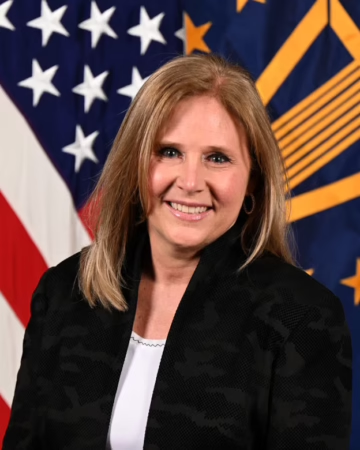
In June the Department of Defense (DoD) unveiled a wide-ranging vision to modernize the agency’s IT networks and compute infrastructure with the aim of providing better user-centric IT capabilities to warfighters around the globe.

But to make that vision a reality, the next step is to mobilize the necessary forces, according to Acting DoD Chief Information Officer (CIO) Leslie Beavers.
Beavers sat down with MeriTalk to discuss how the department plans to “mobilize a commitment to that vision.” This, according to Beavers, is a crucial step because the main challenge she anticipates in executing the “vision” is adoption.
The plan – dubbed Fulcrum: DoD IT Advancement Strategy – is the DoD’s vision for an “infrastructure that is both agile and scalable to meet the dynamic requirements of operations and opportunities offered by the most modern technologies,” the Pentagon said.
According to Beavers, DoD updated its five-year-old digital modernization strategy by adopting a more outcome-focused approach. The Fulcrum strategy encompasses four main areas: strategic capabilities for the warfighter, network modernization, governance, and workforce development.
“The Fulcrum Strategy shapes the vision. Now [we] need to mobilize a commitment to that vision,” Beavers said. “We aren’t trying to reinvent the wheel here, there is a lot of good work already going on.”
Specifically, the DoD CIO is leading several targeted initiatives focused on aligning the 15 objectives and 72 considerations outlined in the strategy against ongoing stakeholder work at the department.
“We are turning the ideas and the objectives that are written down in Fulcrum into tangible capabilities that warfighters can see, because there is nothing in the department that catches on fire faster than something that works and is easy,” Beavers said. “So, if we can make it easy for them and it works, then [they’ll] adopt it.”
Following those efforts the department will refine measurable key results that will guide the development of implementation plans where needed. Public release will depend on the sensitivity of the plans, according to Beavers.
But, she explained, “there’s only so much that you can do within the CIO organization.”
“There’s so much software, internet of things, networked equipment, and pieces that are being developed all over the department in the services. [We] need all those program managers to prioritize interoperability and to think of the warfighter,” Beavers said. “I need all the program managers to prioritize interoperability and adopt the tenets of Fulcrum as it’s built, as they’re solving their problems and building out their capabilities.”
Using AI on the Cybersecurity Front, Securing the DIB
Artificial intelligence (AI) for the department falls under the Chief Data and AI Officer’s oversight, but Beavers’ team is certainly looking at ways to leverage the emerging technology within the cybersecurity realm, including through AI tools that would help the department reach its fiscal year 2027 zero trust goals.
During her recent North East Industry Tour – which ran from August 12-16 and included more than 40 representatives from across the Military Services, Defense Agencies, Field Activities, Homeland Security, and Treasury – Beavers spoke to industry folks on using AI on the cybersecurity front.
The group met with leaders from the financial sector, defense industries, state government, and academia in New York and Boston throughout the week.
“We visited a number of different venture capital companies, traditional defense industrial base companies, and some non-traditional in the financial services world and entertainment industry,” Beavers said. “And we’re confident that there are tools out there that will enable us to achieve our target level zero trust goals.”
From the CIO perspective, she explained, “it’s really our responsibility to get the infrastructure in place so that you can leverage the data and secure the data. So, we’re also looking at [AI] from how do you secure the model, how do you secure the data that it gets trained on, and then how do you leverage it to improve your cybersecurity and your awareness of what’s going on your network?” Beavers said.
Beavers also explained that a key priority for her is securing the defense industrial base (DIB).
“During the industry trip it was also very evident that these companies are facing a nation-state threat. It wasn’t just other companies that were trying to penetrate their networks … it’s nation-state,” Beavers said.
“The goal is to protect the industrial base, which consists of about 300,000 companies, including at least 80,000 that use our controlled unclassified information. We need to support these, especially since many of them are small and medium-sized companies,” Beavers said.
She added that the department is making progress in this area with initiatives like the Cyber Collaboration Center and the DoD Cyber Crime Center, which offers voluntary cybersecurity support for qualifying DIB partners at no charge.
“But I want to scale those types of services and that type of protection to the entire industrial base … which is quite extensive,” Beavers said.
